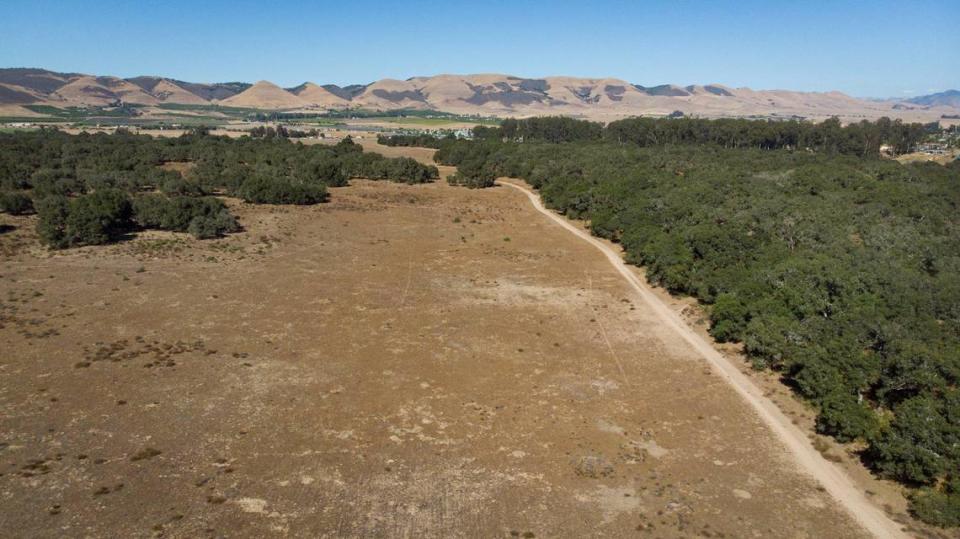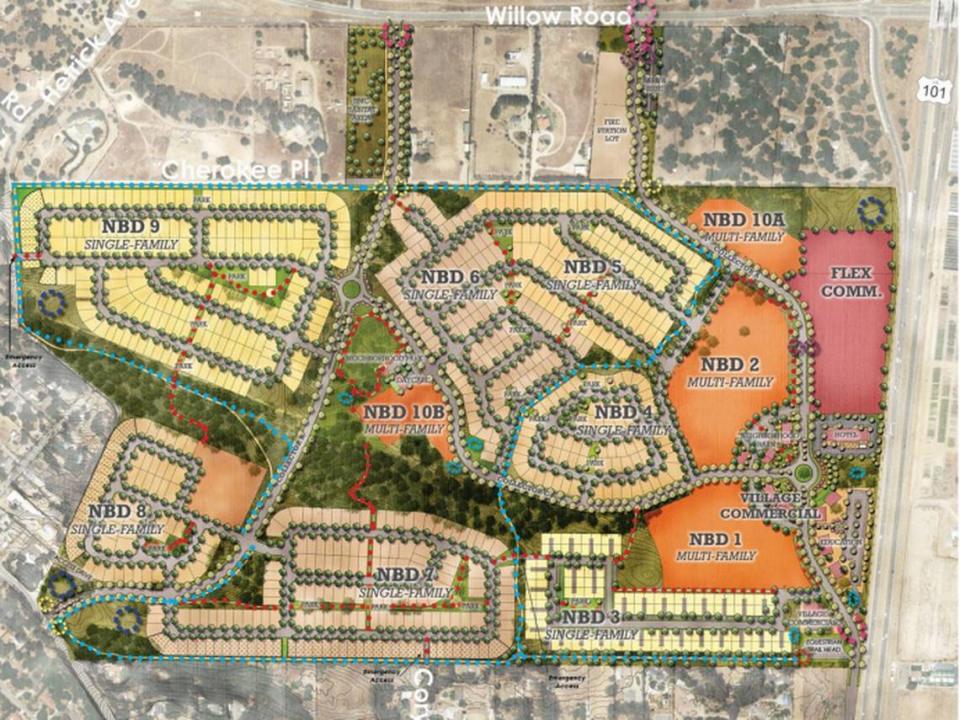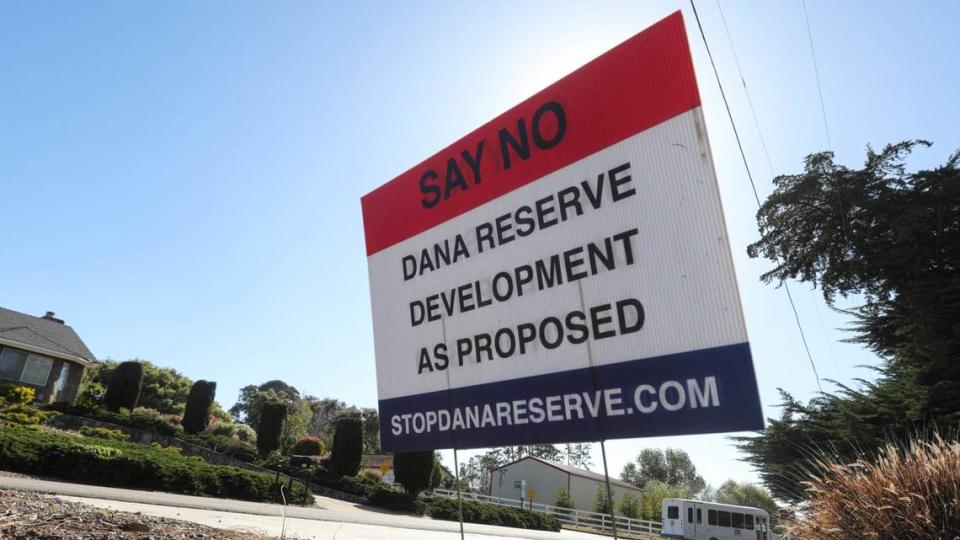Dana Reserve: Everything to know ahead of SLO County housing project’s final hearings
After years of planning, hearings and controversies, the Dana Reserve housing project is headed to its final hearing before the San Luis Obispo Board of Supervisors next week — but there’s more than one way the project could play out.
The most recent version of the Dana Reserve Specific Plan calls for the construction of 1,470 homes on a 288-acre plot of land in Nipomo, but community advocates have voiced concerns over the past two years about the project’s impacts on the local environment and overall fit with the community.
Instead, advocates from the Nipomo Action Committee — a volunteer organization that opposes building the project at its current size — have pushed for a development with a smaller footprint that preserves more of the existing oak tree ecosystem at the site.
At the project’s most recent hearing before the San Luis Obispo County Planning Commission in October, the commissioners approved the plan 4-1, recommending that developer NKT Commercial and county planning staff meet with the Nipomo Action Committee, South County Advisory Council and Nipomo Botanical Garden to develop a community-supported alternative
That alternative, alongside developer Nick Tompkins’ preferred version of the project, will be presented to the Board of Supervisors at the project’s potential final hearing Tuesday and Wednesday.

Developer hopeful hearing will be last step in lengthy planning
Since its last appearance before the Planning Commission, Dana Reserve has undergone some changes to its design, Tompkins told The Tribune.
All said, NKT Commercial’s plan features 417 market-rate single-family homes built by Trilogy Homes builder Shea Homes, 242 units of moderate-income housing, 290 units of missing middle housing, 315 units of workforce housing and a total of 206 low or very low-income homes, according to NKT’s proposal.
Prices in the development are forecast to run the gamut between $475,000 in the multifamily units in Neighborhood 2 and $725,000 for workforce homes in Neighborhood 6 to between $900,000 and $1.2 million in the Shea Homes, said Jocelyn Brennan, a spokesperson for the project and CEO of HRM Consultants.
The wide range of housing types will add hundreds of units to several Regional Housing Need Allocation categories that San Luis Obispo County must approve by 2028, including very low, low and moderate-income homes.
More than 50% of the project’s units will fall between the very low and workforce categories, according to NKT Commercial’s analysis.
Those homes are distributed across the development’s 10 neighborhoods, which were tweaked to accommodate some Planning Commission recommendations.

The Planning Commission asked NKT Commercial to explore removing the age-55-and-up requirement from three single-family neighborhoods — something Tompkins said he was willing to try, though losing the restriction would mean more families and students entering the Lucia Mar Unified School District over the next 10 years.
NKT Commercial has also worked with the San Luis Obispo County Department of Public Works to develop a new protected pedestrian route at Juniper Street and Pomeroy Road that would provide a pedestrian path to nearby schools from the development by way of Nipomo Regional Park, Tompkins said.
Amenity features and mitigation efforts that go beyond what state law requires are part of what makes a project reach this size and cost, Tompkins said.
“I am convinced (the project) brings more to the community and more to people who are in need of housing and families in need of housing than any project ever,” Tompkins said. “I don’t believe the county can use this as an example to hold other builders to, but ... we can do this and we are going to do this.”
Community coalition presents smaller alternative for Dana Reserve
The community-driven alternative maintains many of the Dana Reserve features, such as its commercial center, space for a hotel and the donation of land and funds for a new fire station and Cuesta College satellite campus, but deviates in several key ways.
By changing the placement of neighborhoods and eliminating some of the larger lots from the project, NAC director Alison Martinez said the community alternative calls for removing around 433 trees in total — a far cry from the 3,094 trees that would be removed by the project as it was proposed.
It also adds 66 acres of open space along a ridge in the property, which Martinez said would require fewer grading and landscape changes to the area.
The alternative developed by the Nipomo Action Committee calls for 800 units, consisting of 534 single-family homes and 266 multifamily homes and accessory dwelling units.

Like the original project, the alternative also makes room for 154 units of affordable multifamily housing from People’s Self-Help housing, along with 112 optional mid-income apartments for a total of 266 multifamily units.
Mona Tucker, tribal chair for the yak titʸu titʸu yak tiłhini Northern Chumash Tribe of San Luis Obispo County, said she supports the community alternative because it minimizes harm to old-growth oak forests, which are some of the last standing monuments to the tribe’s environmental legacy.
Tucker said the tribe understands the need for housing and supports initiatives that increase housing while striking a balance with the existing environment.
She said Nipomo’s current housing market can’t support young people who were born in the area and want to stay where they live long-term, but any project looking to solve that problem must account for the ecological and cultural significance of a site before moving forward with a plan.
“You can look at the Egyptians who built the pyramids 4,000 years ago and those pyramids are still standing in a world historical site,” Tucker told The Tribune. “Well, the Northern Chumash didn’t build stone monuments, but part of our cultural identity and legacies are cultural landscapes, and these trees qualify as a cultural landscape in our minds and in our hearts.”

Housing project developer says community alternative isn’t feasible
Though some were happy with the community alternative, others said there was a lack of collaboration and information sharing while attempting to draft it.
Martinez said while the Committee felt comfortable with the alternative it drew up over the course of the past few months, a lack of participation and transparency by developer NKT Commercial has led to concerns that the alternative may be dead on arrival.
Without access to the project’s finances, the Committee can’t be sure their alternative will make financial sense for the developer, Martinez said.
“We asked for the financials for the project so we can create a project that was more feasible, but we weren’t able to obtain the financials,” Martinez said.
Tompkins told The Tribune he didn’t share financial information because he didn’t think the Committee would accept the validity of his cost estimates. He said he also did not share other project information such as soil and grading analysis.
Tompkins said the alternative was “well-intended by most, but done without the benefits and also without the expense of all the engineers and architects and other consultants who worked for two years to come up with a plan that actually worked.”

Tompkins said several findings in an Althouse and Meade, Inc. study that NKT Commercial commissioned on the alternative showed it would not be a good fit moving forward.
The analysis found that the alternative plan severely under-counted the number of oaks that would be removed in that option by more than 1,000 trees.
Another study commissioned by NKT Commercial by Economic & Planning Systems, Inc., found the community alternative was not financially viable, stating that no “reasonably prudent property owner or investor would pursue these alternatives.”
In the past, Tompkins has said including higher-priced and market-rate homes in the project is the only way to keep the rest of the homes affordable — an important consideration when the alternative has shrunk the project’s footprint largely by removing some of the higher-priced neighborhoods.
Herb Kandel, who helped design the alternative plan and has acted as a liaison between the Committee, Nipomo Oak Alliance and Central Coast Student Coalition and the county, said the supervisors should see the alternative plan more of a proof of concept than a fully fleshed out roadmap for construction.
He said the intent of the map is to get the developer to come to the table in good faith and meet community members in the middle — though this would involve taking the project through the planning phase again.
“The housing unit number on the Nipomo Community Map (900) is a consensus number within community coalitions as it reduces overall impacts, but the same building envelope can accommodate additional units,” Kandel said in an email to The Tribune. “It was designed as a concept with flexibility and should be evaluated as such. The developer freezes a flexible concept design sketch in order to demonstrate inflexibility.”

LMUSD gets significant mitigation benefits from project
One of the most pressing concerns voiced by NAC members such as former educators Linda Moran and Tim Crowner was the potential impact to Lucia Mar Unified School District’s existing schools.
As former educators, they said they were concerned the quality of education would decline in Nipomo schools if the influx overburdened teachers and facilities.
Their concerns echoed many of the issues raised by LMUSD Superintendent Paul Fawcett in a Sept. 27 letter to the Board of Supervisors.
“Our review of the project’s environmental impact report (EIR) underscores the considerable strain this development will impose on our already burdened facilities,” Fawcett said in the letter. “Our current school sites clearly cannot accommodate the projected student influx. Furthermore, the EIR hasn’t addressed the inevitable increase in vehicular traffic around our schools.”
At the time, Tompkins said the district’s concerns about a projected 750-student influx didn’t account for Dana Reserve’s 10-year build-out time, which would gradually increase enrollment.

However, in a recent letter from Fawcett to the Board shared by Tompkins, he stated that the district remains neutral on whether the development should proceed.
Tompkins said after meeting with the school district to discuss mitigation strategies, NKT Commercial agreed to donate Neighborhood 10a and its 84 planned homes to the school district, which will work with People’s Self-Help Housing to build inclusionary housing for teachers at no cost to the district.
District teachers and faculty will get the first bite at the homes, which will be deed-restricted to only charge 30% of staff salaries as rent, followed by public employees and then general renters, Tompkins said.
In his letter, Fawcett said NKT Commercial’s mitigation strategy would help fill a “crucial” housing gap in recruiting and retaining district staff.
Tompkins also said dropping the age requirements on Neighborhoods 7, 8 and 9 — along with the existing mitigation fees paid by NKT Commercial — would add enough funds through mitigation fees for the LMUSD to close the gap in funding for facility improvements.

The Board of Supervisors will hear arguments for and against the project during hearings at the Katcho Achadjian Government Center on April 23 and 24

